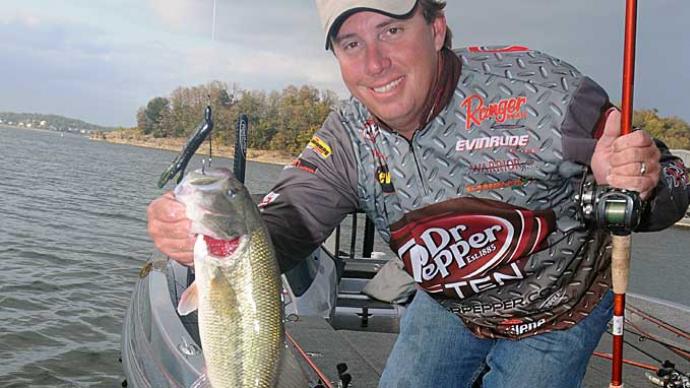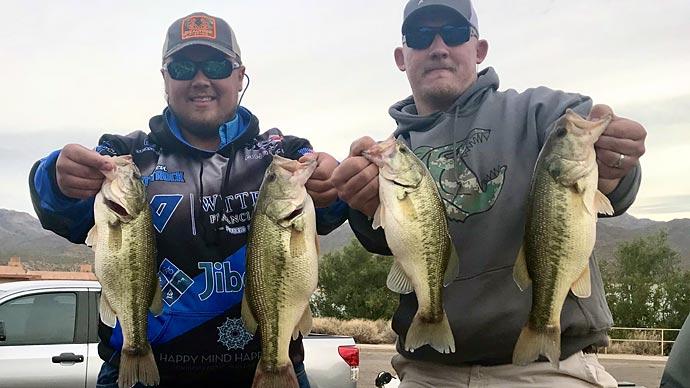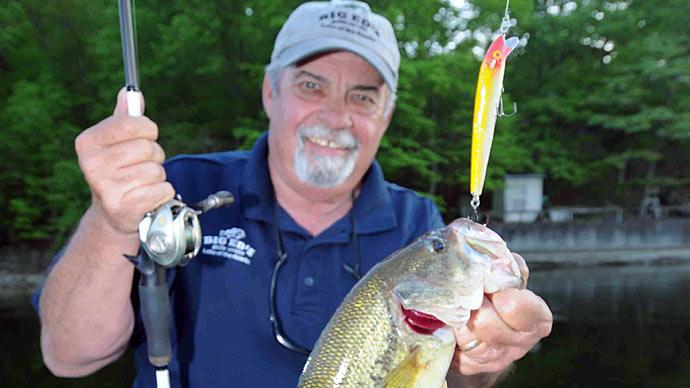
If you have a new fishing pond, and you're wondering how many bass or bluegill or catfish you may catch and eat, the answer is simple. Don't.
Do not remove anything. Leave them all in place.
When a pond matures and fish populations evolve, harvest recommendations require a bit more thought. More on that, plenty more, later, but landowners with new impoundments should forget about eating any of their fish until this time next year.
"First year?" said fisheries biologist Bob Lusk. "Catch-and-release only. Don't even think about taking anything out until end of second year. That's your prime brood stock, and you want to protect those fish."
By the time stocker fingerlings have been in a reservoir for two years, the thoughtful pond managers should begin monitoring growth-rates. This is where pondmeisters are born.
"The first year, you've got your forage fish in place and their numbers grow exponentially," Lusk said. "Right along with it, the bass go from two-inch fingerlings you stock in June, to 8- or 10-inchers by October."
In a healthy, productive pond, these hyperactive, sub-adult largemouth will be 20 percent overweight.
"When those bass start into their second year, a percentage of them will be sexually mature and they will reproduce" said Lusk, a member of the American Fisheries Society who works ponds in Oklahoma, Arkansas, Georgia and Texas.
"So, you've got the original cast of characters, then you got some newcomers that have hatched in your pond. Those are the ones you need to pay attention."
By the end of the second year, the explosive early growth of the bass will begin to subside. Any predator species with a declining growth-rate is almost certainly overcrowded and outstripping its food supply. Mac McCune of the Pond Boss Field Advisory Staff says these conditions can be altered by selecting removing an appropriate number of predators in that size range or year-class.
Simply put: "Those are the ones you need to start taking out," Lusk said.
Say, for instance, you have a pond in Missouri that is full of 12-inch bass. Every third time you cast a spinnerbait, you can catch a 12-incher. That's great fun, but trouble is, the fish have a narrow body profile and you can't seem to catch anything bigger.
According to standards set by the American Fisheries Society, a 12-inch bass should weigh 0.7 pounds. A 14-incher should weigh 1.3, and so on.
These weights were established over years of study by top-drawer fisheries professionals. At the same time, these are target weights and allowances must be made for water temperatures, length of growing season, water quality, elevation and other limiting factors.
Rule of thumb: If you look down on the top of a bass' back, and its gill plates are wider than its torso, the fish is underweight.
In most cases, a bag limit is designed to protect fish in a certain size range. In a pond with too many small bluegill or bass, a fisheries consultant will make a harvest recommendation to remove more fish in a given age or size class, not protect them.
In public waters, this is often referred to as a "slot limit." At Lake Fork, the legendary bass factory in northeastern Texas, the "slot" is 16- to-23 inches. Anglers may keep only those fish that are shorter than 16 inches or longer than 23.
Say, for instance, you stock your pond with bass fingerlings. Three years later, your pond has a world of bass that measure 13 inches. An aggressive fisheries manager will set a limit that encourages anglers to remove a certain number of fish that are less than 14 inches long.
"I call it a reverse slot" Lusk said. "You remove only the fish inside the slot. Everything else gets released."
Lusk says, ideally, he wants his top-end bass to die of old age, with one caveat -- "as long as they are growing" he said. "You want to harvest those young-of- the-year, not the brooders."
Typically, in a well-managed, balanced pond, Lusk suggests harvesting at least 20 pounds of bass per surface acre. He likes to see those fish removed over the course of the year, not all in one day.
When superbly managed, a pond owner could remove more, but he urges caution. "A four-pound bass in a skillet" he said, "has never made it to five pounds."
Longtime fisheries consultant John Foster, who works private reservoirs in the East, says each impoundment is like a snowflake, unique in its own makeup. "Every pond is a little different, so we try to be flexible for each situation'" he said. "A lot of times, we'll tell people who have less than eight (surface) acres of water to make sure they don't return bullheads or crappie.
Like most consultants, Foster, who works the Carolinas for Foster Lake and Pond Management in North Carolina, urges the owners of new ponds to be conservative with their harvest.
"The first year or two, we have people basically release everything else except maybe their bluegill," he said.
In public waters, anglers have a tendency to want to sample the wine before its time. Not in private lakes and ponds. In fact, Foster says the reverse may be true: Pondmeisters practice catch and release to the extreme.
"Most pond owners return all their bass," he said. "Then, if the bass get skinny, it's an indication that food is limited for them."
When bass fall behind in their growth patterns, it's time to either reduce the competition for food or boost the supply of forage, or both. But largemouth are not the only species that may overrun its own food supply. Green sunfish and bluegill, often called "bream" or just "perch," have a tendency to spawn themselves into problems.
Foster, like many pond professionals, has the ideal solution for reducing bluegill populations -- a skillet full of hot peanut oil.
"Often we get into a situation where the sunfish species are over-crowded," Foster said. "That's most likely to happen if people are not catching some for the table. If the bream are not growing fast, we recommend moving some."
Okay, but how many is "In general, in a productive pond that is being fertilized or being fed, we usually say you could remove up to 20 pounds of bass per year, per surface acre," Foster said. "That would be max. Most people don't go that high.
"For bluegill, our rule of thumb is that you could remove 200 pounds per year, and still maintain quality."
Dave Ouawinga may live halfway across the US., but he preaches the same message in the Upper Mid- West.
"In a good, healthy pond that has aeration, you should be able to stock 500-to-600 bluegill to the surface acre, then in a year, if you're feeding them (high-protein pellets), you should be able to harvest 200-300 per acre," said Ouawinga, a fisheries specialist in Grant, MI who runs Stoney Creek and counsels pond owners from Illinois, Ohio and Indiana northward into Wisconsin and Michigan.
In his region, the yellow perch is not merely a novelty species to round out a bass pond; it's a target sportfish in its own right. Light-tackle anglers love catching and eating the stream-lined, green and gold fish that's built like a miniature walleye.
Even in the north country, where growing seasons are 2-to-3 months shorter than in Dixie, a pond that has a supplementary feeding program, along with a solid foundation of fathead minnows, sometimes called "toughies" can withstand heavy harvest pressure on yellow perch and bluegill.
"We tell people they can put 100- to-150 yellow perch in a new pond, and they can harvest nearly that many on a yearly basis," Ouawinga said. In northern waters, where growing seasons may last from May through September, fisheries professionals cut the bass harvest accordingly. Ouawinga urges his Michigan and Wisconsin customers to remove only 10-to-15 pounds of largemouth per surface acre.
Ah, but many pond owners in the West and North of the Mason-Dixon Line enjoy raising trout, especially rainbows.
Given good water quality, these fish can be produced in high volume and will rise to a floating pellet like a tarpon, something you won't see in the fishing shows on cable TV Setting bag limits for trout, however, can be trickier than for bass or bluegill, Ouawinga says.
"If somebody has a trout pond, it gets hard to recommend harvest limits," he said. "The trout requires so much oxygen, such high water quality ... Say, the water temperatures get to 60 degrees. Or maybe it only reaches 55 degrees. That 5 degrees makes so much difference."
In prime conditions, trout may be stocked at high densities, and harvested accordingly.
"Every degree (of water temperature) is critical," Ouawinga said. "In a new pond, we start out with a conservative stocking rate and bag limit. We tell the people to try 50 trout per acre and see what the highest temperature will be at the bottom."
He has seen a high-quality trout pond support 500 fish per acre.
"If you have a spring or an artesian well, you might take out 200 fish per acre," Ouawinga said. "It boils down to your goals. Do you want to go out three nights a week, and catch supper? Or do you plan to fish once a month, hoping to catch a monster?"
Veteran fisheries biologist Mike Mitchell works both cold-water species and warm-water fish from his base in Colorado. He manages a total of 70 streams, lakes and ponds in three western states, waters that lie on both sides of the Continental Divide, at elevations ranging from 4,000-to-8,000 feet.
Mitchell says that for bars, or for trout, harvest limits match the goals of the pond owner.
"You've got to know what your long-term program is going to be," Mitchell said. "If it's a put-and-take operation, then we normally let the client harvest the top-end fish, the one we know that will last only one more year."
A stocker rainbow trout normally lives five years, up to nine in cold water where growth-rates are slow. "We try to take that fish when it's 4 1/2 years old," Mitchell said
In Mitchell's harvest recommendations, hunters should be reminded of a well-managed deer lease or hunting club. Just as the California vineyard will take no wine before it's time, a thoughtful white-tailed deer manager will take no buck before it is at least 4 1/2 years old, preferrably older. Fish for the table, however, is quite another matter.
"If the objective is supplementing your diet with protein -- which happens in 40-to-50 of the ponds -- the people are not really interested in huge fish. They just want to take home a cooler full of fish," Mitchell said.
In those cases, Mitchell suggests stocking 9-to-14 inch rainbows and harvesting an equal number before the fishing season ends. With bass, a fish that size may cost up to $10 a piece, plus delivery, so only a fish-hungry Donald Trump can be so quick with the fillet knife.
Shan O'Gorman of Shan O'Gorman Professional Ponds in Georgia says the public-water mentality of catch-and-release only for bass may not be the best blanket policy for well-established private ponds. In his work in Georgia and South Carolina, O'Gorman is seeing ponds that have too many bass, leading to problems in supplying enough forage to feed them all.
"I'm seeing a lot of ponds where people have transported fish from public reservoirs into their ponds," he said. "You add those predators to your natural reproduction, and you can end up with skinny fish pretty quick."
Like most pond pros working the South, O'Gorman recommends harvesting 20-to-25 pounds of bass per acre, per year. He is, however, cautious about going that high unless he is confident the forage base can restock the shelves.
With bluegill and redear sunfish, sometimes called "shellcrackers," he lets common sense dictate the bag limit. The more fertile and productive the pond, the higher the harvest. He once electro-shocked a lake owned by former Atlanta Braves lefthander Zane Smith , and collected 46 redears over 10 inches long in 45 minutes of work.
Obviously, that particular pond could support a vigorous harvest.
Reprinted with permission from Pond Boss Magazine



